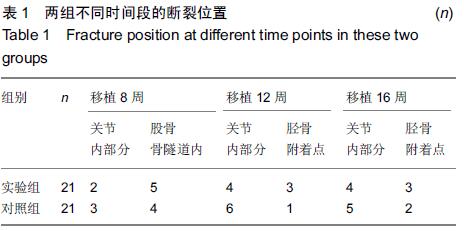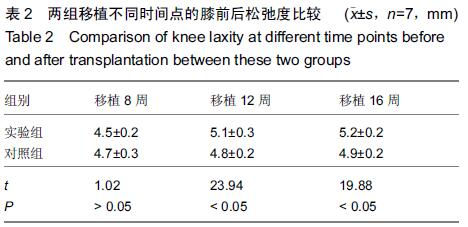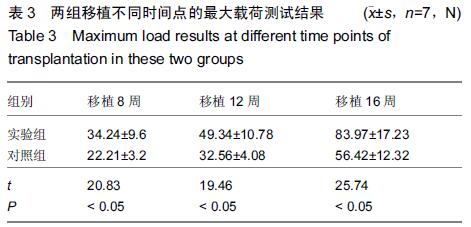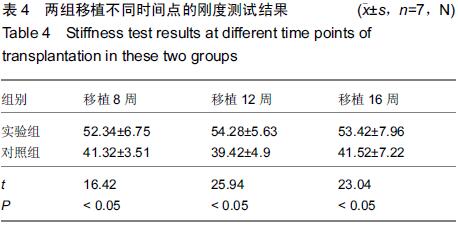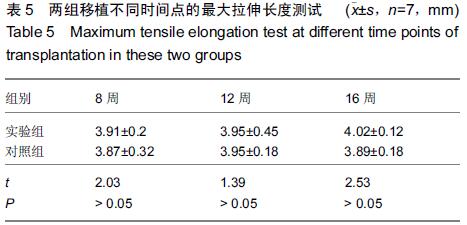[1] 孙康,王立德,张羽飞.人工合成材料重建膝关节交叉韧带的进展[J].骨与关节损伤杂志,2000,15(3):236-238.
[2] 李祥明.人发人工腱材料修复膝关节交叉韧带和侧副韧带的疗效观察[J].云南医药,2003,24(1):33-34.
[3] 陆晓涛,李其训,王宇飞,等.人发角蛋白人工腱在膝关节前交叉韧带损伤中的应用[J].骨与关节损伤杂志,2003,18(6):402-403.
[4] 康一凡.关节镜下LARS人工韧带重建后交叉韧带及有限切开重建外侧副韧带[J].中国骨与关节损伤杂志,2008,23(3): 202-204.
[5] 范钦波,范继峰.关节镜下先进人工韧带加强系统和四股自体半腱肌腱重建前交叉韧带的疗效比较[J].中国修复重建外科杂志,2008,22(6):676-678.
[6] 王先采,张伟,孙水,等.关节镜下四股胭绳肌肌腱移植重建前交叉韧带术后康复[J].中华物理医学与康复杂志,2007,29(9): 637-639.
[7] Rotter N,Haisch A,Bücheler M.Cartilage and bone tissueengineering for reconstructive head and neck surgery.Eur Arch Otorhinolaryngol.2005;262(7):539-545.
[8] Du C,Cui FZ,Zhang W,et al. Formation of calcium phosphate/ collagen composites through mineralization of collagen matrix. J Biomed Mater Res.2000;50(4):518-527.
[9] 韩伟.人工膝关节置换治疗重症膝关节病118例[J].中国组织工程研究与临床康复,2009,13(35):6995-7000.
[10] 谢正阳,侍勇,刘志元.人工膝关节在运动性损伤中的应用[J].中国组织工程研究与临床康复,2010,14(22):4093-4096.
[11] 孙鲁宁,蔡文辉,沈计荣.人工全膝关节置换术后肌力锻炼对假体膝关节功能的作用[J].中国临床康复,2003,7(32):4415-4418.
[12] 胡金萍.几种高分子生物材料屏障作用预防肌腱粘连的系统评价[J].中国组织工程研究与临床康复,2009,13(29):5793-5797.
[13] 王庆丰.武术运动踝关节骨损伤原理与组织工程学康复术[J].中国组织工程研究与临床康复,2011,14(38):7153-7156.
[14] 吴文杰,刘树江,王臣.全膝关节置换术非技术性常见失败原因分析[J].临床医药实践杂志,2008,1(8):618-620.
[15] 王鹏,宣昭鹏,赵承斌,等.个体化钛合金掌指关节假体的生物力学研究[J].中国组织工程研究与临床康复,2010,14(26): 4770-4773.
[16] 白凤德,刘光耀,朱兴华,等.槽型自动加压防拔钉接骨钢板的设计、生物力学研究及应用[J].试验技术与试验机,1997,37(2): 61-63.
[17] Rhinelander FW,Wilson JW. Blood supply to developing mature and healing bone. In Sumner~Smith G (ed). Bone in Clinical Orthopaedics: A Study of Clinical Osteology,chap 2. Philadelphia,WB Saunders,2012.
[18] 王彩梅,毛恩荣.个体化人工膝关节假体的计算机辅助设计[J].中国组织工程研究与临床康复,2008,12(44):8661-8664.
[19] 纪斌平.人工膝关节置换术[J].人人健康,2009,28(4):33-33.
[20] 章培建.人工膝关节置换相关问题的临床问答[J].中国组织工程研究与临床康复,2009,13(12):2560-2560.
[21] 赵艳.人工膝关节的生物摩擦学特点[J].中国组织工程研究与临床康复,2010,14(22):4090-4093.
[22] Weiss JA,Maakestad BJ.Permeability of human medial collateral ligament in compression transverse to the collagen fiber direction.J Biomech.2006;39(2):276-283.
[23] Kock HJ,Sturmer KM,Letsch R,et al. Interface and biocompatibility of polyethylene terephthalate knee ligament pros theses. A his tological and ultras tructural device retrieval analys is in failed synthetic implants used for surgical repair of anterior cruciate ligaments.Arch Orthop Trauma Surg.2014; 114(1):1-7.
[24] 张弛,蒋垚,炳芳,等.组织工程学前交叉韧带人工韧带的特征[J].中国组织工程研究与临床康复,2007,11(6):1150-1151.
[25] Handl M,Drzik M,Cerulli G,et al. Reconstruction of the anterior cruciate ligament: dynamic strain evaluation of the graft. Knee Surg Sports Traumatol Arthrosc.2007;15(3): 233-241.
[26] 党培业,牛东生,白志刚.全膝关节置换治疗膝关节高度屈曲畸形的临床研究[J].宁夏医学杂志,2010,32(4):349-350.
[27] 沈奕,宋德业,王万春.旋转铰链式膝关节假体置换治疗复杂膝关节疾病[J].中国组织工程研究与临床康复,2009,13(35): 6931-6934.
[28] 刘渝松,马善治,郭亮,等.中医综合治疗优化方案治疗膝关节骨性关节炎150例临床观察[J].实用中医药杂志,2012,28(1):5-8.
[29] 陈大伟,张方建,白书臣,等.中医外治三联法治疗膝骨性关节炎6 0例临床观察[J].中医杂志,2012,53(5):399-332.
[30] 刘建卫,黄培祥.鹿瓜多肽注射液配合中药外洗治疗膝关节骨性关节炎疗效观察[J].中国医学创新,2013,10(1):133-134.
[31] 林桦楠,陈海鹏.膝关节骨性关节炎关节镜术后注射玻璃酸钠的临床研究[J].中国医学创新,2013,10(3):8-9.
[32] 崔永红,章晓华.玻璃酸钠联合鹿瓜多肽治疗膝关节骨性关节炎疗效观察[J].中国医学创新,2013,10(5):56-57.
[33] 赵钦福,王文,李云,等.关节镜下有效选择性治疗中老年膝关节骨性关节炎[J].中国医学创新,2013,10(8):16-17.
[34] 董瑞华,郑立新,张鲁阳,等.药物熏蒸治疗类风湿关节炎临床观察[J].中国医学创新,2013,10(12):35-37.
[35] 林国聪.抗-CCP与RF检测对类风湿性关节炎的临床意义[J].中国医学创新,2012,9(8):82-83.
[36] 赖爱云,徐健,梁维,等.甲氨蝶呤联合来氟米特治疗类风湿关节炎的疗效观察[J].中国医学创新,2012,9(10):32-33.
[37] 罗世兴,赵劲民,苏伟,等.保留和不保留后交叉韧带全膝置换疗效的Meta分析[J].中国矫形外科杂志,2010,18(14):1145-1146.
[38] 党培业,牛东生,白志刚.全膝关节置换治疗膝关节高度屈曲畸形的临床研究[J].宁夏医学杂志,2010,32(4):349-350.
[39] Mihalko WM,Miller C,Krackow KA.Total knee arthroplasty ligament balancing and gap kinematics with posterior cruciate ligament retention and sacrifice. Am J Orthop.2010;29(8): 610-616.
[40] Yaglshita K,Muneta T,Shinomiya K.Quantitative evaluation of the effect of soft tissue release on soft tissue balance in total knee arthroplasty. J Bone Joint Surg (Br).2011;83:439.
